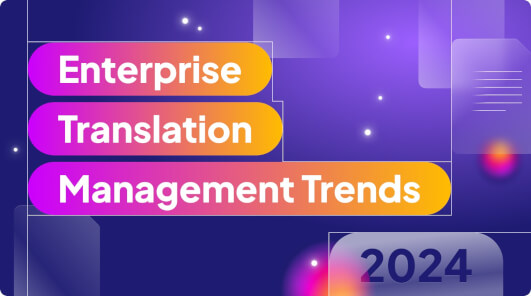Globalization can provide important benefits to businesses in many industries, such as accessing new markets to increase revenue and diversify beyond a reliance on home markets, increasing revenues, and identifying new product opportunities. To maximize success overseas, businesses that expand operations globally must navigate different regulatory and data privacy environments, manage cultural differences, and overcome language barriers. These challenges can hinder communication and impede a business’s ability to form strong relationships with customers and business partners.
Global enterprise translation management and the ability to develop high-quality, accurate multilingual content are central to executing successful global strategies, especially in go-to-market campaigns around international expansion. This process goes beyond simple translation to also incorporate different cultural contexts, local norms, behaviors, and legal requirements. The right enterprise translation management solutions position companies to ensure culturally correct, accurate translation for specific markets. It’s no wonder that the translation services market is expected to soar to $53.5 billion by 2032.
How do translation management systems work?
A translation management system (TMS) streamlines the process of translating content across multiple languages by automating workflows, managing translation memory, ensuring consistency with terminology management, integrating machine translation, and providing tools for quality assurance.
The best translation management platforms facilitate collaboration among translators, editors, and project managers to optimize efficiency, reduce manual errors, and accelerate project completion times. They also support global communication strategies by making it easier to manage large volumes of multilingual content.
7 transformative trends in translation management
Enterprise translation management is witnessing several powerful trends as a result of technological advancements and changing market demands:
1. Diversification of language demand
The demand for translation services is expanding beyond traditional languages to include languages driven by emerging markets such as Swedish, Polish, Indonesian, Thai, Vietnamese, Danish, and Norwegian. This shift reflects global economic developments and the increasing internet accessibility across different regions, necessitating businesses to broaden their linguistic repertoire to cater to a more diverse audience.
As a result, there's an increasing demand for localization services as businesses tailor their content to meet the cultural and linguistic preferences of diverse global audiences. This means content must be not just translated but culturally adapted and tuned for local markets. Effective content translation and localization sharpen a brand's voice across languages and audiences. It also helps to maintain consistency and enhance customer engagement by making products and marketing messages culturally relevant and legally compliant.
2. Increased integration of AI and machine learning
Another trend is the integration of AI and machine learning into translation workflows. These technologies are becoming more adept at handling complex translations and understanding contextual nuances, making them indispensable for global communication strategies. Integration involves using neural networks and machine-learning algorithms to analyze and learn from large datasets of existing translations.
AI-powered translation management solutions adapt over time to better recognize patterns, grammar, and context. They can also refine translations based on feedback, significantly enhancing efficiency and accuracy, and helping organizations adapt to multiple languages and dialects at scale.
3. Adoption of neural machine translation (NMT)
The rise of neural machine translation technology is transforming enterprise translation by offering more natural and accurate translations. Unlike previous methods that translated content piece by piece, NMT considers the whole context, learning from vast amounts of data to produce translations that are linguistically accurate and contextually appropriate. They understand the subtleties of language, significantly reducing the need for human post-editing. NMT continuously improves as it encounters more text, making it highly effective for complex and varied language pairs.
4. Growth in video content localization
Visuals can transcend linguistic barriers, making a company’s messages engaging and universally understandable. It facilitates emotional connections, making brands more relatable and memorable across different cultures. However, localizing video content to reach a global audience includes translating the spoken words as well as graphics and illustrations, subtitles, voiceovers, and on-screen text. Top enterprise platforms for content translation include the ability to work with video content.
5. Enhanced focus on multilingual SEO
Localizing search engine optimization (SEO) enhances online visibility in targeted regions and improves user experience, by presenting content in the local language and context. This leads to better search rankings in local search queries and drives more relevant traffic to websites. In fact, 65% of businesses generate better SEO results, and 67% see an improvement in content quality.
6. AI translation with a human touch
According to CSA Research, the integration of AI translation into content strategies is crucial for meeting the needs of global users, regardless of the organization's type or size. That’s why the machine translation market is expected to grow at a CAGR of 15.19% from 2022 to 2027, reaching more than $1,022.6 million.
However, integrating the human touch with translation technology is also essential. Humans can interpret and adapt translations to reflect local customs, humor and idioms, preserving the original message's intent and emotional tone. Combining AI's efficiency with a human understanding of context and cultural nuances of language increases translation accuracy. It also helps to ensure the content is culturally appropriate.
7. Continued rise of the translation management system (TMS)
Driven by the need for efficiency and consistency in managing large-scale, multilingual content projects, more e nterprises are adopting sophisticated translation management software to streamline their translation processes. A TMS offers advanced features such as translation memory, automated workflow management, and quality assurance tools, to help manage translations efficiently. It also reduces manual errors and helps maintain brand consistency across languages.
Using a TMS enables effective, real-time collaboration across global teams and accelerates time-to-market for localization projects, as well, by reducing the workload and complexities of manual translation management.
These trends underscore a rapidly evolving translation and localization industry. Enterprises that understand and embrace these trends will gain a competitive edge. For example, Stanley Black and Decker used a Language AI platform to translate their Learning and Development training materials into several languages. Thanks to the AI-driven platform and access to a marketplace for connecting businesses with translation professionals, Stanley Black & Decker reduced translation project costs by 70% and decreased its average translation turnaround time by 2 weeks, while significantly boosting the quality of the translated content.
Another global organization, Welcome Pickups, leveraged translation management with impressive results. The company provides personalized transfer services and tailor-made experiences in 99 destinations worldwide, working with an international network of established partners like Aegean, Crowne Plaza, and Novotel. After ditching their manual translation process and localizing their content, Welcome Pickups cut translation times by 50% and increased bookings by 66%.
Tackle globalization with Smartcat
The increasingly global nature of business will necessitate fast, accurate localization of all types of content, from product and marketing deliverables to in-product text, video content, documentation, and more. Robust translation and localization practices will be indispensable for businesses to thrive globally in 2024 and beyond, enabling seamless entry into diverse markets and helping businesses connect with local audiences.
Smartcat is a comprehensive cloud-based platform designed to streamline the translation and localization process. It offers a range of tools and services, including AI-powered translation, an embedded marketplace of over 500,000 vetted linguists, and AI human workflow automation features. Smartcat helps companies manage translation projects with solutions for collaboration and quality assurance that integrate with various business tools. It aims to make translation accessible and efficient for businesses of all sizes, supporting a wide array of languages and file formats.
Don’t miss the chance to capitalize on the trends that are impacting the growing market for enterprise translation management systems. Learn how Smartcat can help you enhance translation speed and quality, and tackle globalization challenges more effectively.
Subscribe to our newsletter



